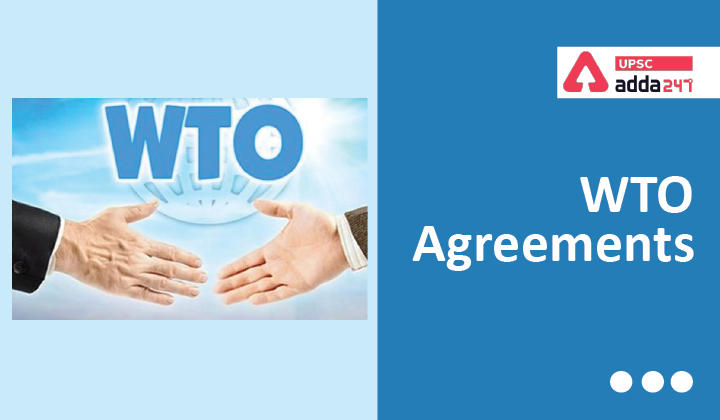Table of Contents
WTO Agreements: Relevance
- GS 2: Bilateral, regional and global groupings and agreements involving India and/or affecting India’s interests.
In the previous article, we have discussed about the WTO principles. In this article, we will discuss about the WTO agreements, and WTO and India relations.
The Marrakesh Agreement
- This is an agreement for implementing the results of the Uruguay Round and establishing the World Trade Organization, The Agreement comprises general provisions on the WTO’s organization, membership, decision-making, etc.

Agreement on Agriculture
- The WTO Agreement on Agriculture contains provisions in 3 broad areas of agriculture and trade policy: market access, domestic support and export subsidies.
Market Access
- This includes tariffication, tariff reduction and access opportunities.
- Tariffication: It means that all non-tariff barriers such as quotas, variable levies, minimum import prices, etc. need to be abolished and converted into an equivalent tariff.
- Ordinary tariffs including those resulting from their tariffication were to be reduced by an average of 36% with minimum rate of reduction of 15% for each tariff item over a 6-year period.
- Developing countries were required to reduce tariffs by 24% in 10 years.
- Special safeguard provision allows the imposition of additional duties when there are either import surges above a particular level or particularly low import prices as compared to 1986-88 levels.
Domestic Support
- For domestic support policies, measured by the Total Aggregate Measure of Support (total AMS), should be reduced by 20% in developed countries (13.3% in developing countries).
- Reduction commitments refer to total levels of support and not to individual commodities.
- De-minimum level: Policies which amount to domestic support at less than 5% of the value of production for developed countries and less than 10% for developing countries also excluded from any reduction commitments.
Export Subsidies
- The Agreement contains provisions regarding members commitment to reduce Export Subsidies.
- Developed countries are required to reduce their export subsidy expenditure by 36% and volume by 21% in 6 years, in equal installment (from 1986 –1990 levels).
- For developing countries, the percentage cuts are 24% and 14% respectively in equal annual installment over 10 years.
Agreement on the Application of Sanitary and Phytosanitary (SPS) Measures
- The SPS Agreement provides a framework of rules to guide WTO Members in the development, adoption and enforcement of sanitary (human or animal life or health) and phytosanitary (plant life or health) measures which may affect trade.
- The right to adopt SPS measures is accompanied by obligations aimed at minimising negative impacts of SPS measures on international trade.
- The basic obligations are that SPS measures must:
- be applied only to the extent necessary to protect human, animal or plant life or health and not be more trade restrictive than necessary;
- be based on scientific principles and not maintained without sufficient scientific evidence; and
- not constitute arbitrary or unjustifiable treatment or a disguised restriction on international trade.
Agreement on Textiles and Clothing
- Textile trade was governed by the Multi-Fiber Arrangement (MFA) since 1974. The agreement provides that textile trade should be deregulated by gradually integrating it into GATT disciplines over a 10-year transition period. The agreement expired at the end of 2004.
Agreement on Trade-Related Investment Measures (TRIMs)
- TRIMs, covered under Marrakech Agreement, addresses investment measures that are trade related and that also violate WTO principles.
- It is an agreement that requires investment to be freely allowed by nations.
- The agreement restricts the use of three TRIMS requirements: local content requirements, trade balancing requirement and foreign exchange balancing requirements.
Anti-Dumping Agreement
- This agreement aims to tighten and codify disciplines for calculating dumping margins and conducting dumping investigations, etc. in order to prevent anti-dumping measures from being abused or misused to protect domestic industries.
Agreement on Subsidies and Countervailing Measures
- This agreement aims to clarify definitions of subsidies, strengthen disciplines by subsidy type (extension of the range of prohibited subsidies, etc.), and to strengthen and clarify procedures for adopting countervailing tariffs.
Agreement on Trade-Related Aspects of Intellectual Property Rights (TRIPS)
- This agreement stipulates most-favored-nation treatment and national treatment for intellectual properties, such as
- copyright,
- trademarks,
- geographical indications,
- industrial designs,
- patents,
- IC layout
- It also requires member countries to maintain high levels of intellectual property protection and to administer a system of enforcement of such rights.
Also Read:
| JPC on Data Protection Bill | Data Localisation: Advantages and Challenges | Biological Diversity (Amendment) Bill 2021 | The Grasslands of the World |
| SOLAW Report 2021 | World Trade Organisation (WTO) | India Loses WTO Dispute over Sugar Subsidies | National Leprosy Eradication Programme |
| Green Day Ahead Market | 44th Constitutional Amendment Act | One Commodity One Exchange’ Policy | Gaganyaan Space Mission |




 TSPSC Group 1 Question Paper 2024, Downl...
TSPSC Group 1 Question Paper 2024, Downl...
 TSPSC Group 1 Answer key 2024 Out, Downl...
TSPSC Group 1 Answer key 2024 Out, Downl...
 UPSC Prelims 2024 Question Paper, Downlo...
UPSC Prelims 2024 Question Paper, Downlo...
